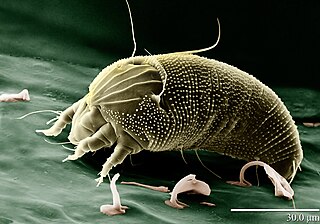
Gymnosporangium juniperi-virginianae is a plant pathogen that causes cedar-apple rust. In virtually any location where apples or crabapples (Malus) and eastern red cedar coexist, cedar apple rust can be a destructive or disfiguring disease on both the apples and cedars. Apples, crabapples, and eastern red cedar are the most common hosts for this disease. Similar diseases can be found on quince and hawthorn and many species of juniper can substitute for the eastern red cedars.

Aceria is a genus of mites belonging to the family Eriophyidae, the gall mites. These tiny animals are parasites of plants. Several species can cause blistering and galls, including erineum galls. A few are economically significant pests, while others are useful as agents of biological pest control of invasive plants such as rush skeletonweed, creeping thistle, and field bindweed.
Stigmella oxyacanthella is a moth of the family Nepticulidae, found in Europe and North America. The larvae are leaf miners feeding inside the leaves of trees and shrubs, such as hawthorn, apple and pear.

Aceria anthocoptes, also known as the russet mite, rust mite, thistle mite or the Canada thistle mite, is a species of mite that belongs to the family Eriophyidae. It was first described by Alfred Nalepa in 1892.

Phyllocoptes is a genus of acari, including the following species:

Phyllocoptes eupadi is a mite that chemically induces a pouch gall to develop as a sub-spherical distortion rising up from the upper surface of the lamina of leaves of blackthorn shrubs Prunus padus, Prunus spinosa and other Prunus species. Synonyms are Phytoptus padi Nalepa, 1890 and "Eriophyes padi ", non Eriophyes padi Domes, 2000.

Aceria fraxinivora, also known as the cauliflower gall mite and the ash key gall, causes the growths, known as galls, found on the hanging seeds or "keys" of the ash (Fraxinus) species.

Aculus craspedobius is a species of mite which causes galls on the leaves of willows. It was first described by Alfred Nalepa in 1925.

Aculus magnirostris is a species of mite which causes galls on the leaves of willows. It was first described by Alfred Nalepa in 1892.

Aculus tetanothrix is a species of mite which causes galls on the leaves of willows. It was first described by Alfred Nalepa in 1889.

Aculus laevis is a species of mite which causes galls on the leaves of sallows. It was first described by Alfred Nalepa in 1892.

Phyllocoptes goniothorax is a species of mite belonging to the genus Phyllocoptes, which causes galls on the leaves of hawthorns. It was first described by Alfred Nalepa in 1889.

Acalitus brevitarsus is an eriophyid mite which induces domed, blister like swellings, known as galls, on some species of alder.

Eriophyes laevis is a gall mite which makes small, pimple-like galls on the leaves of alder. The mite was first described by the Austrian zoologist, Alfred Nalepa in 1889 and is found in Europe and North America.
Acalitus plicans is an eriophyid mite which causes galls on beech. It is found in Europe and was first described by the Austrian zoologist Alfred Nalepa in 1917.
Acalitus stenaspis is an eriophyid mite which causes galls on beech. It is found in Europe and was first described by the Austrian zoologist Alfred Nalepa in 1891.

Aceria nervisequa is a species of mite that belongs to the family Eriophyidae. It is found in Europe and was first described by Giovanni Canestrini in 1891. The mite causes galls on the leaves of beech,
Acalitus calycophthirus is an eriophyid mite which causes big bud galls on birch twigs. It is found in Europe and was first described by the Austrian zoologist, Alfred Nalepa in 1891.

Aceria elongata, the crimson erineum mite, is a species of eriophyid mite. This microscopic organism induces erineum galls on the upper leaf surfaces of sugar maple, and is known from the east coast of United States and Canada.

Epitrimerus trilobus is a gall mite in the family Eriophyidae, found in Europe. The mites feed on the leaves of elder (Sambucus species), causing abnormal plant growths known as galls. The mite was described by the Austrian zoologist, Alfred Nalepa in 1891.













